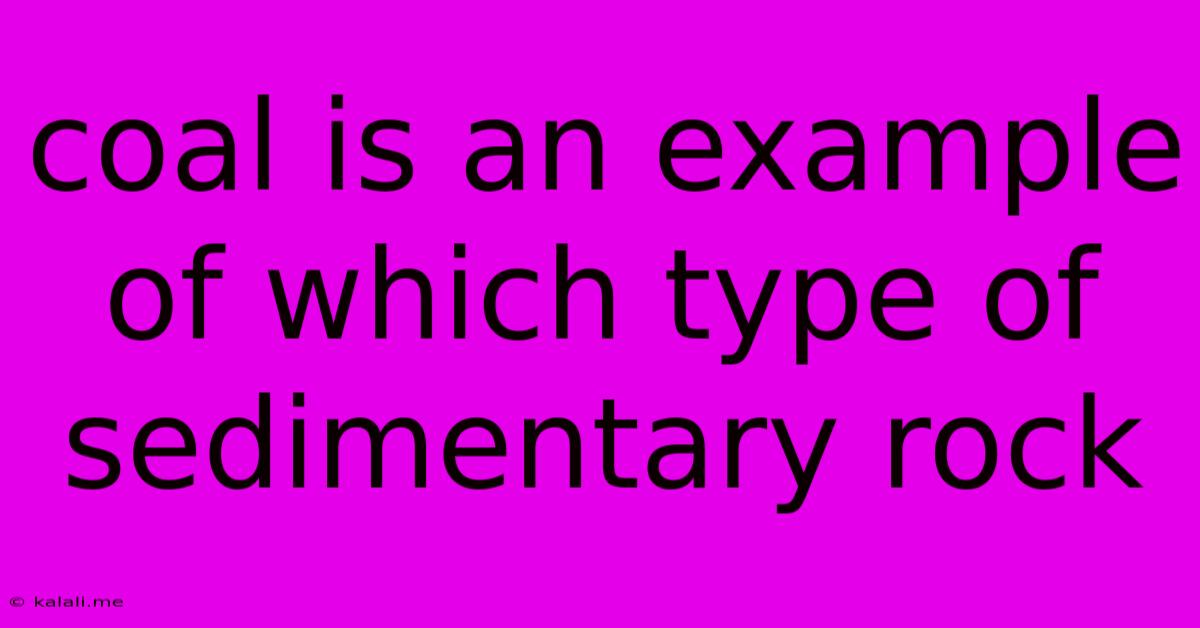Coal Is An Example Of Which Type Of Sedimentary Rock
Kalali
Jun 13, 2025 · 3 min read

Table of Contents
Coal: A Sedimentary Rock Formed from Ancient Plant Matter
Coal, a crucial energy source for centuries, is a fascinating example of a sedimentary rock. Unlike igneous rocks formed from cooled magma or metamorphic rocks altered by heat and pressure, coal's origin lies in the accumulation and transformation of organic matter, specifically ancient plant remains. This article will delve into the specifics of coal formation, its classification within sedimentary rocks, and its unique characteristics.
Understanding how coal forms is key to understanding its classification. The process begins with the accumulation of large quantities of plant material in swamps and bogs, often in environments with limited oxygen. This prevents the complete decomposition of the plant matter, allowing it to accumulate in thick layers. Over millions of years, these layers are buried under sediment, increasing pressure and temperature. This process, known as diagenesis, transforms the plant material through several stages:
- Peat: The initial stage, where partially decayed plant matter accumulates. Peat is still relatively high in water content and is often found in bogs today.
- Lignite (Brown Coal): With increasing pressure and temperature, peat loses water and undergoes further decomposition, forming lignite. Lignite is a soft, brown coal with a relatively low energy content.
- Bituminous Coal: Further burial and compaction lead to the formation of bituminous coal, a harder, black coal with a higher carbon content and energy density than lignite. This is the most common type of coal used for power generation.
- Anthracite Coal: Under extreme pressure and temperature, bituminous coal can be transformed into anthracite, the hardest and most metamorphosed type of coal. Anthracite has the highest carbon content and energy density, burning with a very clean flame.
Coal's classification as a sedimentary rock stems from its formation process: the accumulation of sediment (in this case, plant material), its layering, and the diagenetic changes it undergoes over time. While the final product, especially anthracite, shows some characteristics of metamorphism due to the intense heat and pressure, its origin as an accumulation of organic sediment firmly places it within the category of sedimentary rocks. The layered structure often visible in coal seams is another strong indicator of its sedimentary nature.
While coal is primarily classified as a sedimentary rock, its journey through geological time showcases the interplay between sedimentary and metamorphic processes. The progressive increase in carbon content and the hardening of the coal reflect the influence of increasing pressure and temperature, characteristics associated with metamorphism. This explains why some geologists might refer to anthracite as having metamorphic characteristics, but its origin remains undeniably sedimentary.
In summary, coal's formation, from the accumulation of plant debris to its transformation into various ranks, underscores its classification as a sedimentary rock. Although the higher-rank coals exhibit some metamorphic traits due to the intense pressure and heat experienced during their formation, their origins remain firmly rooted in the accumulation and alteration of organic sediments. This understanding is fundamental to both geological studies and the responsible utilization of this vital energy resource.
Latest Posts
Latest Posts
-
14 Principles Of Scientific Management By Frederick Taylor
Jun 14, 2025
-
Ultimate Tensile Strength Of Cast Iron
Jun 14, 2025
-
What Is Scientific Name Of Snake
Jun 14, 2025
-
Ringers Solution Contains Which Of The Following
Jun 14, 2025
-
What Is The Prime Factorization Of 93
Jun 14, 2025
Related Post
Thank you for visiting our website which covers about Coal Is An Example Of Which Type Of Sedimentary Rock . We hope the information provided has been useful to you. Feel free to contact us if you have any questions or need further assistance. See you next time and don't miss to bookmark.